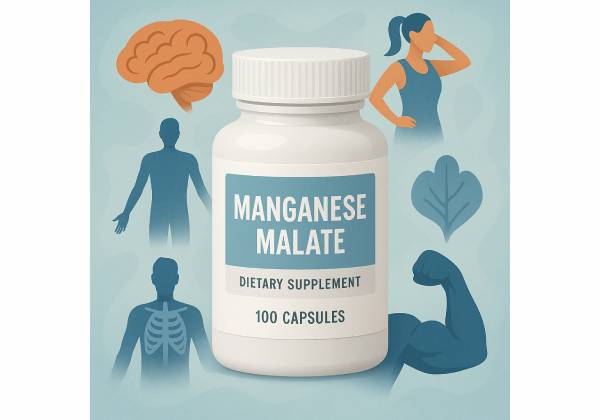
Manganese malate is a supplemental form of manganese—the essential trace mineral your body uses to activate enzymes that protect cells, build connective tissue, and support normal metabolism. In this salt, manganese is paired with malic acid, a compound that naturally participates in the Krebs (citric acid) cycle. On a label, the important number is the elemental manganese provided per serving, not the total weight of manganese malate. Because most people already obtain manganese from food—particularly whole grains, legumes, nuts, tea, and coffee—this supplement is best used to top up intake rather than to push high doses. The body absorbs only a small fraction of manganese and eliminates most excess through bile, so liver and biliary health are central to safety. In the pages below, you will find clear guidance on what manganese malate can and cannot do, conservative dose ranges, timing with meals and medications, common mistakes to avoid, who should not take it, and a practical read of today’s evidence so you can decide whether it belongs in your routine.
Quick Overview
- Supports mitochondrial antioxidant enzymes and connective tissue formation; benefits are mainly about meeting daily needs.
- Typical supplemental range: 0.5–3 mg elemental manganese per day; count total from diet and products.
- Keep total daily manganese below conservative adult ceilings set by authorities; long-term excess can be neurotoxic.
- Avoid self-supplementation if you have liver or biliary disease, iron deficiency, or occupational manganese exposure.
Table of Contents
- What is manganese malate?
- Does it work and for what?
- How much to take and when
- What affects absorption and results
- Mistakes, interactions, and who should avoid
- Evidence snapshot and practical verdict
What is manganese malate?
Manganese malate is a salt formed from manganese and malic acid. In the digestive tract, it dissociates to release manganese ions (Mn²⁺), which the body can absorb in modest amounts, and malate, which cells can metabolize through the citric acid (Krebs) cycle. The malate part may sound appealing because of its role in energy metabolism, but at the tiny doses used in trace-mineral supplements, it does not add meaningful “energy” on its own. What matters biologically is whether the supplement delivers enough elemental manganese to support manganese-dependent enzymes without overshooting safe totals.
Inside the body, manganese plays a catalytic role rather than a structural one. It activates several enzyme families, including:
- Antioxidant defense: Manganese is the metal at the core of manganese superoxide dismutase (MnSOD), the mitochondrial enzyme that disarms superoxide radicals.
- Connective tissue and bone: Manganese-dependent glycosyltransferases help assemble proteoglycans and collagen components that give cartilage bounce and bone its resilient matrix.
- Metabolism: Manganese supports enzymes involved in carbohydrate and lipid pathways as well as urea cycle activity.
Total body manganese stores are small—roughly a few dozen milligrams—with the largest share in bone. The intestine tightly regulates absorption (often just a few percent of intake), and the liver excretes most excess through bile. That is why liver and biliary function are crucial to manganese safety and why chronic overexposure can become a neurological issue: if the body cannot excrete manganese effectively, levels may rise in the brain over time.
Why choose malate specifically? Manufacturers often use organic acids such as malate, citrate, or gluconate to create salts that dissolve well, mix cleanly into tablets or capsules, and are generally gentle on the stomach. For manganese specifically, no strong human evidence shows that malate is superior to other common forms when you compare equal elemental doses. Tolerability, clear labeling of elemental content, and thoughtful dosing matter more than the exact salt.
Food remains the best source for most people. Whole grains (like oats and brown rice), beans, nuts, leafy greens, coffee, and tea routinely provide enough manganese to meet daily needs without a pill. Supplements can still be useful in niche scenarios—restricted diets, multivitamins with little or no manganese, or clinician-guided bone or joint formulas that include a small amount of the mineral.
Does it work and for what?
The honest answer is that manganese malate works for what manganese is meant to do: help your enzymes operate normally. That is a real benefit but not one you feel like a stimulant or pain reliever. Here is how expectations should line up with the evidence.
Antioxidant defense you don’t feel—but depend on. MnSOD is the mitochondria’s primary line of defense against a common reactive oxygen species, superoxide. If a diet chronically lacks manganese, MnSOD activity can drop, increasing oxidative stress in high-energy tissues (muscle, heart, brain). Restoring manganese intake corrects the cofactor deficit. However, taking more than enough manganese does not supercharge MnSOD beyond normal. The goal is adequacy, not “extra.”
Connective tissue and bone support that is additive, not magical. Manganese helps build proteoglycans and collagen scaffolding for cartilage and bone. Animal studies show poor skeletal development with manganese deficiency. In humans, a few small trials and observational signals suggest manganese may contribute to bone metrics as part of a multi-nutrient approach that also includes calcium, vitamin D, vitamin K, protein, and weight-bearing activity. As a solo agent, manganese is not a treatment for osteoporosis or joint pain.
Metabolic roles without a supplement shortcut. Manganese-dependent enzymes participate in gluconeogenesis and lipid processing. Observational studies sometimes link manganese status (in blood, hair, or toenails) with blood sugar or lipids, but such markers track exposure more than function, and findings conflict across populations. The best-supported metabolic improvements come from dietary patterns—fiber-rich, minimally processed foods—rather than from manganese tablets.
Who is most likely to benefit from a supplement? People whose diets are very low in whole plant foods; those on medically restricted regimens that lack variety; or individuals whose multivitamin contains little or no manganese. In these cases, adding a small, clearly justified dose can bring intake up to daily targets and support enzyme systems quietly in the background.
What manganese malate does not do. It is not a performance enhancer, mood booster, or quick fix for skin, hair, or sleep. Claims that “malate” specifically creates noticeable energy are more marketing than science at the usual doses provided in trace-mineral products. If you feel markedly different after starting a multi-ingredient supplement, other components (e.g., magnesium, B vitamins, caffeine from added green tea) are more plausible explanations.
Bottom line: Manganese malate can be useful to meet needs, especially when diet is limited. Beyond adequacy, the evidence does not support chasing higher doses for extra benefit—and doing so raises risk without clear upside.
How much to take and when
Start with the numbers that matter. For adults, typical daily targets from all sources (food plus supplements) are about 2.3 mg/day for men and 1.8 mg/day for women. Many balanced diets already provide 2–6 mg/day from food alone. Authorities also set conservative upper bounds for chronic intake to minimize risk. A cautious rule of thumb for adults is to keep total daily manganese below 8–11 mg/day, depending on jurisdictional guidance. Treat these ceilings as limits, not goals.
Pragmatic supplemental ranges. If you and your clinician decide to include manganese malate:
- Everyday top-up: 0.5–2 mg elemental manganese/day is sufficient for most people whose diet is somewhat limited but not extreme.
- Multivitamin users: Many multis supply 1–2.3 mg. If your diet includes whole grains, nuts, beans, and tea, that is often plenty—no stand-alone manganese needed.
- Single-ingredient capsules: These frequently provide 5–10 mg or more per serving. For routine use, those doses are usually higher than necessary and may push totals toward conservative ceilings once diet is counted. Unless a clinician directs otherwise, prefer lower-dose products.
Label literacy that prevents overdoing it. The Supplement Facts panel should list “Manganese (as manganese malate)” and the elemental amount in milligrams. That is the number you add into your daily total. Ignore marketing emphasis on the compound’s weight.
Timing with meals and minerals. Take manganese malate with food to reduce stomach upset and mimic natural intake. If you also take iron or calcium, space them at different meals because these minerals can compete for intestinal transport. If you take an iron supplement in the morning, move manganese to the evening, or vice versa.
How long should you take it? For most healthy adults, manganese is a short-to-medium-term helper to bridge a dietary gap. Try 8–12 weeks, then re-evaluate your diet quality and total intake. Long-term daily use without a clear indication is unnecessary and can be risky if your health status changes (for example, new liver or biliary problems).
Special cases and life stages.
- Pregnancy and lactation: Needs are modestly higher, but standard prenatal vitamins generally cover them. Avoid stacking a separate manganese supplement unless your clinician recommends it.
- Children and adolescents: Do not use stand-alone manganese supplements unless a pediatric clinician prescribes them.
- Athletes: There is no credible evidence that manganese above adequacy improves performance or recovery. Focus on dietary quality and iron status.
Practical dosing examples (elemental manganese):
- Your multivitamin provides 2 mg, and your diet includes oats, beans, and nuts most days. You likely meet needs; skip added manganese.
- Your diet is low in whole grains and legumes, and you do not take a multi. Consider 1 mg/day manganese malate for a few months while improving your menu.
- You drink several cups of tea daily (a meaningful manganese source), take a bone formula with 2–4 mg, and also use a multivitamin with 2 mg. You may be near conservative ceilings—simplify the stack.
What affects absorption and results
Manganese absorption is self-adjusting: when intake is low, the gut absorbs a larger fraction; when intake is high, absorption falls and the liver increases biliary excretion. Still, several real-world factors can tilt how much manganese you actually retain.
Iron status is pivotal. Iron and manganese share transport pathways in the intestine. When iron stores are low, the body upregulates those transporters, which can increase manganese absorption from the same dose. If you are treating iron deficiency, keep manganese supplementation minimal and separate dosed minerals throughout the day as advised by your clinician.
Diet composition and beverage habits.
- Tea and coffee contain manganese; tea can be a particularly rich source. Polyphenols in these beverages can bind minerals, yet in practice, regular tea drinkers often meet manganese needs through diet alone. If you take a manganese pill with tea, absorption may be somewhat lower; consider taking supplements with water and food instead.
- Phytate and fiber (bran, legumes) can bind minerals. However, manganese requirements are low, and varied meals usually provide enough despite phytate. Only very high-phytate, low-variety diets pose a realistic risk of under-absorption.
Other minerals compete. Large, single-time doses of calcium, iron, magnesium, or zinc can crowd one another. If your regimen includes multiple minerals, split doses—for example, iron at breakfast and a multivitamin with manganese at dinner—to avoid unnecessary interference.
Form differences are subtle. For manganese, robust human data do not show clinically meaningful differences in absorption between malate and other common salts (gluconate, citrate, sulfate, “bisglycinate”). The deciding factors are your tolerability, the elemental dose, and timing relative to other minerals and medications. Choose a form you digest comfortably, verify the elemental amount, and keep the dose conservative.
Health conditions that change the risk calculus.
- Liver or biliary disease (including cholestasis): Because manganese is excreted in bile, impaired flow can cause manganese to accumulate, raising the risk of neurological effects over time. In such cases, avoid manganese supplements unless a specialist directs them.
- Infants and young children: They absorb a higher fraction of ingested manganese compared with adults and have lower safe thresholds. Do not provide discretionary manganese supplements to children.
- Occupational exposure: Welders and others exposed to airborne manganese should not add supplemental manganese without professional guidance.
Environmental sources matter. Some well water contains measurable manganese. If you rely on a private well, consider a simple mineral analysis, especially if household members also use multi-mineral supplements or if there are infants in the home.
Tolerability tips. If manganese malate causes mild nausea, take it mid-meal or switch to a lower elemental dose. In many cases, discomfort comes from tablet binders, colorants, or large pills rather than the manganese salt itself; a different brand or a smaller dose often solves the problem.
Mistakes, interactions, and who should avoid
Common mistakes to avoid
- Chasing high doses. More manganese is not better. Your enzymes need “enough,” and extra intake adds risk without upside.
- Stacking products unknowingly. A multivitamin may provide 1–2.3 mg; a bone or joint formula might add 2–4 mg; tea contributes more. Always add up total elemental manganese from all sources.
- Taking with interacting medications. Certain antibiotics do not mix with minerals (details below).
- Ignoring liver and biliary health. Because excretion relies on bile, any condition that impairs bile flow changes the safety equation.
Drug and nutrient interactions
- Fluoroquinolone and tetracycline antibiotics. Manganese and other polyvalent cations chelate these antibiotics in the gut, sharply reducing absorption. Separate doses by a wide window—commonly at least 2 hours before or 4–6 hours after the antibiotic—per your pharmacist’s guidance.
- Iron therapy. High-dose iron competes for transport; take it at a separate time of day and keep manganese dosing low while correcting iron deficiency.
- Levodopa and some thyroid medications. Minerals can blunt absorption; follow your clinician’s timing instructions for all mineral supplements if you take these medicines.
- Calcium and magnesium megadoses. Large single doses can reduce manganese absorption; split minerals across meals.
Who should avoid manganese supplements (unless prescribed and monitored)
- People with liver or biliary disease (including cholestasis).
- Individuals with parkinsonism or other movement disorders.
- Anyone with occupational manganese exposure (e.g., welding) or known high environmental exposure.
- Infants and children, unless a pediatric specialist prescribes manganese for a specific reason.
- Those with iron deficiency until iron status has been corrected and a clinician confirms manganese is appropriate.
Side effects and red flags
- Typical tolerability: Most adults notice nothing at low doses with food; occasional mild nausea can occur if taken on an empty stomach.
- Concerning signs with chronic excess or impaired excretion: Headaches, irritability, sleep changes, slowed movements, tremor, gait imbalance, or other neurological symptoms. If these appear—and you take multiple mineral products or have liver/biliary issues—seek medical care and review total exposure, including drinking water.
Practical safety rules to live by
- Prefer food first; use manganese malate to fill a documented gap.
- Keep supplemental elemental manganese low (often 0.5–2 mg/day).
- Track daily totals across diet, water, and products; stay below conservative adult ceilings.
- Separate from interacting antibiotics and high-dose iron or calcium.
- Reassess every few months or sooner if your health status changes.
Evidence snapshot and practical verdict
Dietary sufficiency is the norm. Dietary surveys in Europe and the Nordics consistently place typical adult intake between 2 and 6 mg/day from food alone. In such settings, frank deficiency is rare; risk rises at the other end of the curve when people stack multiple supplements or have impaired excretion. That is the core reason authorities emphasize conservative safe levels, not aggressive dosing, for chronic daily intake.
Form comparisons are not decisive. For manganese, high-quality human trials comparing malate with gluconate, citrate, sulfate, or bisglycinate are limited. Health-professional guidance focuses on elemental dose and total exposure rather than a specific salt. The malate form is reasonable for tolerability and formulation, but it is not uniquely superior at equivalent elemental doses.
Enzyme-level roles are established; clinical claims are modest. Manganese is indispensable for mitochondrial MnSOD and for enzymes that build cartilage and bone matrix. That biochemistry underpins the common practice of including small manganese doses in bone or joint formulas, where multiple nutrients work together. In isolation, manganese supplements have not shown consistent, clinically large effects on bone density, glucose control, or athletic performance in well-nourished adults.
Safety focuses on the brain and bile. The best-documented serious risk from chronic excess is neurological—parkinsonian features arising from manganese accumulation in basal ganglia structures. Occupational inhalation is the clearest risk scenario, but oral overexposure matters too, especially when biliary excretion is impaired or when total intake is quietly high over months to years. Respect conservative ceilings, avoid stacking, and be alert to new neurological symptoms.
Medication interactions are real, preventable, and common. Polyvalent minerals interfere with the absorption of certain antibiotics. The fix is simple: separate doses by hours or temporarily pause nonessential minerals during antibiotic courses as your prescriber advises.
Practical verdict for people-first use.
- If your diet includes whole grains, legumes, nuts, and tea, you likely meet manganese needs without a supplement.
- If you choose manganese malate, do so to reach, not exceed, daily targets—often 0.5–2 mg/day elemental manganese is plenty.
- Keep total intake (diet plus supplements) below conservative adult ceilings and re-check your regimen whenever your diet, medications, or health status changes.
In short, manganese malate is a useful tool for closing small gaps, not a lever for extra performance. Aim for adequacy, dose low, and let your diet carry most of the load.
References
- Manganese – Health Professional Fact Sheet 2021 (Guideline)
- Scientific opinion on the tolerable upper intake level for manganese 2023 (Guideline)
- Manganese – a scoping review for Nordic Nutrition Recommendations 2023 2024 (Systematic Review)
- Manganese-Induced Parkinsonism: Evidence from Epidemiological and Experimental Studies 2023 (Systematic Review)
- Multivalent cations interactions with fluoroquinolones or tetracyclines: A cross-sectional study 2021 (Observational Study)
Disclaimer
This article is for educational purposes only and is not a substitute for professional medical advice, diagnosis, or treatment. Always talk with a qualified healthcare professional before starting, stopping, or changing any supplement—especially if you are pregnant or breastfeeding; have liver, biliary, neurological, or iron-related conditions; take prescription medications; or are considering doses above typical multivitamin levels. If you notice new neurological symptoms or other concerning effects while using manganese, stop the supplement and seek medical care.
If this guide was helpful, please consider sharing it on Facebook, X (formerly Twitter), or the platform you prefer, and follow us for future evidence-based articles. Your support helps us continue creating high-quality health content.










